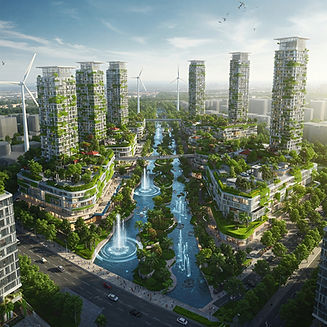

Our Commitment to Sustainability.
Ecosign commitment to sustainability has a strong connection to the technologies offered by the company.
Our goals include provide innovative and effective solutions for wastewater treatment and environmental protection.
The application of our technologies directly contributes to a more sustainable development model by effectively addressing pollution, preserving natural resources, and minimizing environmental impacts. This makes it a key technology to tackle environmental challenges and promote global sustainability.
Reduce operational costs while enhancing sustainability efforts, creating a positive impact for future generations by maintaining the same quality of water, air, and soil.

Advanced Water Treatment Technologies & Sustainability

Reduction of Persistent Pollutants
Multioxidative System is capable of degrading persistent organic pollutants, which are often not eliminated by conventional processes. This reduces contamination of water bodies, promoting the preservation of natural resources.

Low Generation of Secondary Waste
Multioxidative often converts pollutants into carbon dioxide, water, and mineral salts, minimizing the generation of solid waste or sludge, which would require environmentally safe disposal at high costs.

Reduction of Environmental Impact
By eliminating or transforming toxic and bio accumulative compounds, Multioxidative System helps reduce the environmental impacts caused by industrial and urban pollution, supporting healthier ecosystems.

Water Resource Recycling
Multioxidative makes it possible to reuse treated water, especially in industries and urban areas. This approach reduces the demand for natural water resources, contributing to sustainable water management.

Energy Efficiency
With the advancement of technology, it is possible to minimize energy consumption, especially when combined with renewable sources.

Alignment with Sustainable Development
MOS is aligned with the UN’s Sustainable Development Goals, particularly in the areas of Clean Water and Sanitation and Responsible Consumption and Production, by ensuring efficient wastewater treatment and promoting the responsible use of resources.
PFAS
Per- and polyfluoroalkyl substances (PFAS) are a group of human-made chemicals widely used in industrial and consumer products due to their water, grease, and heat-resistant properties. Found in items such as non-stick cookware, waterproof fabrics, food packaging, and firefighting foams, PFAS have been in use for decades.

Why Are PFAS a Concern?
PFAS are often called "forever chemicals" because they do not break down easily in the environment or the human body. Studies have linked prolonged exposure to PFAS with health risks, including hormonal disruption, immune system effects, and increased risks of certain cancers. These chemicals can contaminate drinking water, soil, and even the food supply, making their regulation and removal a growing global concern.
How Can PFAS Be Managed?
Due to their persistence, PFAS require advanced treatment solutions for effective removal from water sources and industrial processes. Technologies such as activated carbon filtration, ion exchange, and advanced oxidation processes (AOPs) have proven effective in reducing PFAS contamination.
At Ecosign, we offer cutting-edge water treatment solutions designed to mitigate PFAS pollution, helping industries and municipalities achieve cleaner, safer water. Contact us to learn how our innovative technologies can support your sustainability goals.
Top Water Treatment Methods for PFAS Removal
%20for%20water%20treatment.jpg)
Advanced Oxidation Processes
-
An innovative technology that uses hydroxyl radicals to degrade PFAS into less harmful byproducts.
-
Can be combined with other methods for increased efficiency.

Ion Exchange
-
Ion exchange uses resins to capture PFAS from water.
-
It is particularly effective for removing short-chain PFAS, which are more difficult to treat with activated carbon.
-
The process offers a longer lifespan and can be regenerated in some cases.

Activated Carbon Adsorption
-
Granular activated carbon (GAC) is commonly used to capture PFAS, particularly long-chain compounds.
-
It is highly effective and ensures consistent performance.

Reverse Osmosis
-
Reverse osmosis is a highly effective method for removing PFAS from water.
-
It uses semipermeable membranes to filter out contaminants and is commonly beneficial for polishing and refining water to achieve high-quality results.
-
This process produces a concentrated waste stream that requires proper treatment.


How the Ecosign Multioxidative System Can Help Treat PFAS in Water
The Ecosign Multioxidative System is an advanced Advanced Oxidation Process (AOP) technology designed to break down persistent organic pollutants, including PFAS (per- and polyfluoroalkyl substances). AOPs are highly effective in degrading contaminants by generating powerful oxidants, such as hydroxyl radicals (•OH), which can break down the strong carbon-fluorine bonds that make PFAS so resistant to conventional treatments.
Integration with Other Technologies
The Ecosign Multioxidative System can be implemented in combination with existing technologies to enhance overall treatment efficiency:
🔹 Pre-treatment: Used before filtration systems (such as activated carbon or ion exchange) to reduce PFAS concentration and prevent overloading.
🔹 Post-treatment (Polishing): Applied after primary treatment to further degrade remaining PFAS or other residual contaminants.
🔹 Parallel Treatment: Used alongside other technologies to manage byproducts and secondary pollutants generated during PFAS removal.
With its flexibility and high efficiency, the Ecosign Multioxidative System offers a comprehensive solution for addressing PFAS contamination, ensuring cleaner water and improved environmental safety.

Building the Future
Smart Cities represent an innovative urban development model that integrates technology, strategic planning, and sustainability to create more efficient, resilient, and livable cities. Among the key pillars of these intelligent cities, sustainable energy and water treatment and reuse stand out as fundamental elements for a balanced and environmentally responsible future.
Sustainable Energy: Efficiency and Impact Reduction
In a world where sustainability is no longer an option but a necessity, adopting efficient and eco-friendly energy solutions is crucial. Our commitment to sustainable energy focuses on reducing environmental impact while maximizing efficiency, ensuring that industries, businesses, and communities can thrive responsibly.


Water Treatment and Reuse: A Valuable Resource
Access to clean water and the efficient management of water resources are central challenges for any city. Innovative technologies such as advanced purification systems, smart distribution networks, and the reuse of treated wastewater play a crucial role in preserving this resource. Efficient wastewater treatment and rainwater harvesting are fundamental strategies to ensure a sustainable supply and minimize environmental impacts.
Benefits for Society and the Environment
Benefits of a Sustainable Energy
The adoption of sustainable solutions in Smart Cities not only improves the quality of life for citizens but also promotes a healthier and more resilient urban environment. Reduced pollution, conservation of natural resources, and optimized infrastructure are some of the positive impacts of this city model. Moreover, public policies aligned with innovation and sustainability encourage community participation in building a greener future.
Smart Cities are the key to a more sustainable world, where technology and environmental responsibility go hand in hand to create a balanced and efficient urban environment. The commitment to sustainable energy and proper water management are essential steps in this transformation, ensuring that future generations can enjoy intelligent and sustainable cities.








